How We Do It: Developing & Implementing a District-wide Focus on Communication and Core Vocabulary (Part 2)

We’re back with Georgia-based SLP Jennifer Ro to hear more about a district-wide rollout of AAC in which they established (and have maintained) a core vocabulary focus.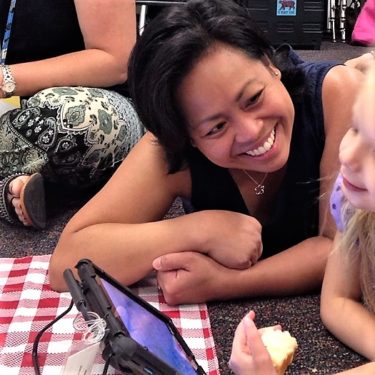 Jennifer is currently the lead AAC-SLP on Forsyth County Schools’ Assistive Technology Team where she provides AAC implementation support and trainings for staff and families and conducts individual AAC student consults.
Jennifer is currently the lead AAC-SLP on Forsyth County Schools’ Assistive Technology Team where she provides AAC implementation support and trainings for staff and families and conducts individual AAC student consults.
You can see Part 1 of the post here. Today, Jennifer shares some of what they learned in the process of creating AAC materials for the classroom and supporting the implementation of those materials. Let’s continue with more ‘lessons learned’ from this AAC experience.
=================
How We Do It: Developing, Implementing a District-wide Focus on Communication & Core Vocabulary
(Part 2)
How we did it. And keep doing it … 😉
- Create and develop supplemental materials that can be utilized universally and then modified, if needed, for individual student or teacher needs.
… Use feedback from others to facilitate staff’s ability to incorporate core vocabulary (CV) throughout the day
… Develop parent trainings and reach out to private providers.
… Connect with other school districts starting out and doing neat things.
… Share, share, share!
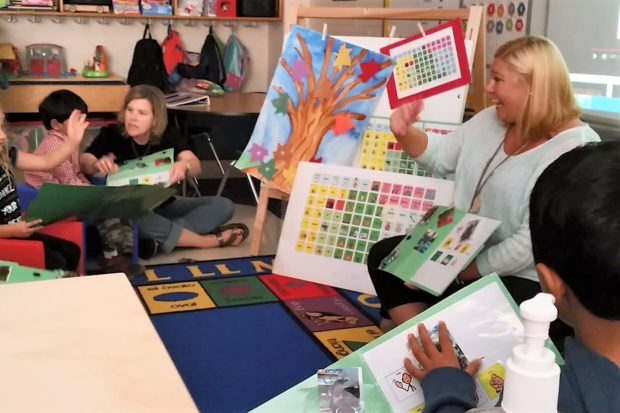 We focused first on a standard 84-location core word board (CWB) in 3 different sizes: poster-sized (class use), folder-sized (small-group or individual use), and paper-sized (individual use).
We focused first on a standard 84-location core word board (CWB) in 3 different sizes: poster-sized (class use), folder-sized (small-group or individual use), and paper-sized (individual use).
As our CWB’s use became widespread, we heard from others how they wished they had something similar for other purposes. Now, we have a variety of other tools and visual supports that incorporate the CWB vocabulary, icons, and concepts of our original 84-location CWB. These additional supports help maintain consistency for use of our original CWB, despite the various needs and requests.
Along with this, we conducted and scheduled supplemental training events available to staff, parents, and/or private service providers. These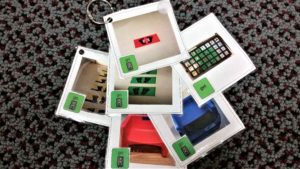 have included an AAC Camp, informational trainings for parents on CV, a parent dinner event talking only with AAC devices, and various AAC-related or device trainings with a nod towards CV.
have included an AAC Camp, informational trainings for parents on CV, a parent dinner event talking only with AAC devices, and various AAC-related or device trainings with a nod towards CV.
Some of the materials developed include:
– “Pull-off” CWBs (poster-size and folder-size) with corresponding “phrase strips.”
Purpose: To highlight targeted words or phrases for students that need this.
To provide teachers a way to target early literacy/writing by allowing students to “pull-off” words to form phrases.
– Standard static display boards for a variety of mid-tech voice output devices.
Purpose: To mirror the location and vocabulary of the 84-location CWB for students who benefited from additional voice output. The overlays were purposefully designed to coordinate both key vocabulary and location pending the number of cells on the mid-tech device.
– Spanish-version of the 84-location CWB, designed with our bilingual SLP.
Purpose: To provide a means for our Hispanic students to communicate using words learned in school with their Spanish-speaking only parents. Though the multiple meanings of the English words did not always translate 1:1; we selected the Spanish words that corresponded to how our English-speaking teachers would most often use the word in the classroom.
– A speaking version of the CWB that can be utilized on interactive whiteboards.
Purpose: To allow teachers to model for the class with voice output.
– A “lanyard version” of the CWB.
Purpose: To provide a “wearable” CWB that can be added with all the other visual supports that our teachers actively wear.
– Additionally, common visual supports in our district were modified to include target CV words. Those modified now include behavioral visual supports for the wall or that can be worn on a lanyard, transition visual supports, turn-taking supports, social-emotional regulation supports, and visual schedule supports.
Many of the above items were requested or made by our own teachers and SLPs and subsequently shared. They are all a part of Forsyth’s “CV tool box.” Their use helps maintain the CV emphasis throughout the day.
Though after 3 years we were pleased with how our goals were moving forward, we also realized that CV and communication is just one aspect of the bigger picture, albeit a large one.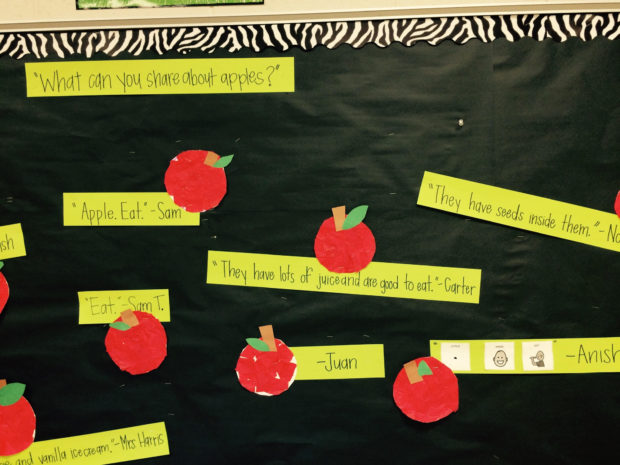
- Continue training/implementation on CV and communication, but provide training on other concepts to give staff additional knowledge to “dig deeper.” With these additional tools, teachers have greater ability to reflect and problem-solve and can therefore independently and effectively modify their teaching strategies when needed.
… Identify the bigger picture and the additional factors that impact implementation.
… Provide new layers of information to help teachers target core vocabulary more purposefully based on individual student abilities and opportunities noted in the classroom.
… Think outside the box to meet training and implementation needs creatively.
With increased prevalence and experiences with CV and the CWB, more information is necessary for teachers and SLPs to be effective for the wide range of student skill levels in the classroom. Teachers now need more of the “why” to facilitate reflection and develop independence in shifting their teaching strategies to meet student needs.
Teachers’ and SLPs’ early CV teaching experiences provide them a personal framework in which they can now “hang” or relate additional layers of information provided. We moved from the “just do it” phase to one where our teachers were ready to “dig deeper.”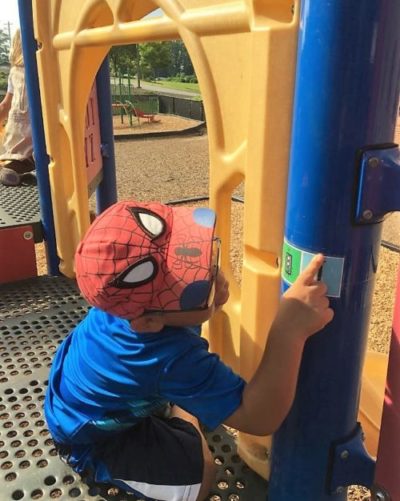
Our repertoire of training and implementation support has expanded to include content on typical language development, social-communication development, student engagement during instruction, tiers of support, Universal Design for Learning (UDL), visual supports, and facets of peer coaching and mentoring.
As we visited classrooms, we noted that special attention was needed towards “weeds,” essentially related areas of implementation that affect staff efficacy for developing communication. At times we wondered, “Are we straying from our main goals?” After reflection, we realized that we were trying to grow and maintain a healthy garden. These additional implementation concepts provide staff a deeper, layered base of knowledge.
We anticipate that this layered foundation will help our teachers to ultimately facilitate the best outcomes for our students. So, we’ve fully embraced the “weeds” and come to realize that they are truly not extras, but quite integral to our long-term communication goals for our students.
We have heard from current staff that we are changing mindsets here, not just about core vocabulary and communication, but on what will make a tremendous impact for our students during school and for life after.
Thankfully district administration has taken note and we now have 2 full-time AAC-SLP positions (1 full-time SLP and 2 others who are half-time). But, there is still much to do!
Our district continues to grow and recent data indicates our special education population is outpacing the growth in overall student enrollment. With this growth, combined with the usual student transitions, changing staff, and new initiatives, keeping pace remains challenging. Creative thinking and looking at how CV and communication correlated with others’ goals in our district now shares the stage.
- Collaborate with others just outside your immediate area and continue #4
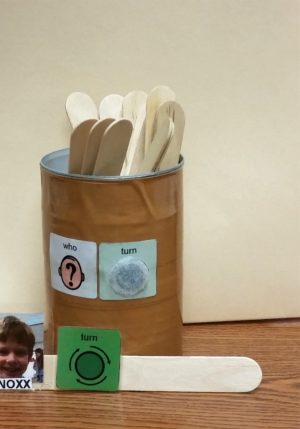
… Establish relationships with other disciplines, programs, and departments.
… Be open to learning about and including other ideas that may not be directly related to CV goals, but also positively impacts the foundation already in place.
… Identify potential areas of interest and look to collaborate on goals that may be of mutual benefit.
Hard to believe that we started Step 1 almost 5 years ago! Steps 1-3 were instrumental in getting started and spreading the word. Step 4 has provided us with deeper knowledge and allowed us to see connections to the goals of other programs and of the district, as a whole.
Break down the silos and develop new relationships while supporting current ones at the school and district levels, as well as with those outside the district. We are currently dabbling in collaborations with our Autism, ID, PreK, and General Education programs and have established connections with other metro Atlanta school districts and organizations.
As our district gets larger, it’s been beneficial to share our experiences with others and to learn about the experiences and concerns of other programs and staff.
It’s been interesting to me; all of us working in the public schools have the same long-term goal to prepare our students to be contributing members of the community as much as is possible. Yet, it’s often easy to overlook this common thread since the varied departments, roles, and disciplines, each plays a different part in preparing students. But in essence, we all work towards the same overall outcome.
Though I was aware of this commonality within our various settings and roles, actually knowing it and “feeling it” has really made a difference for me. There is joy and a purpose as I go about work; and definitely more so, with this increased sense of camaraderie and openness to collaboration.
To be perfectly clear, things are far from the ideal in our district and there are many opportunities ripe for development. In regard to CV and communication, we’re still working on #4 and #5 (and sometimes #3). It’s a constant process balancing the needs for staff training, implementation, and looking at individual student needs. But, being aware of the potential opportunities, where you would like to be, and what is needed get there is half the battle.
To end, have fun relishing in the neat things we, in the public schools, have the opportunity and potential to do!
“Turn it on … Get out … Do Good.” Would love to hear how big your garden grows!
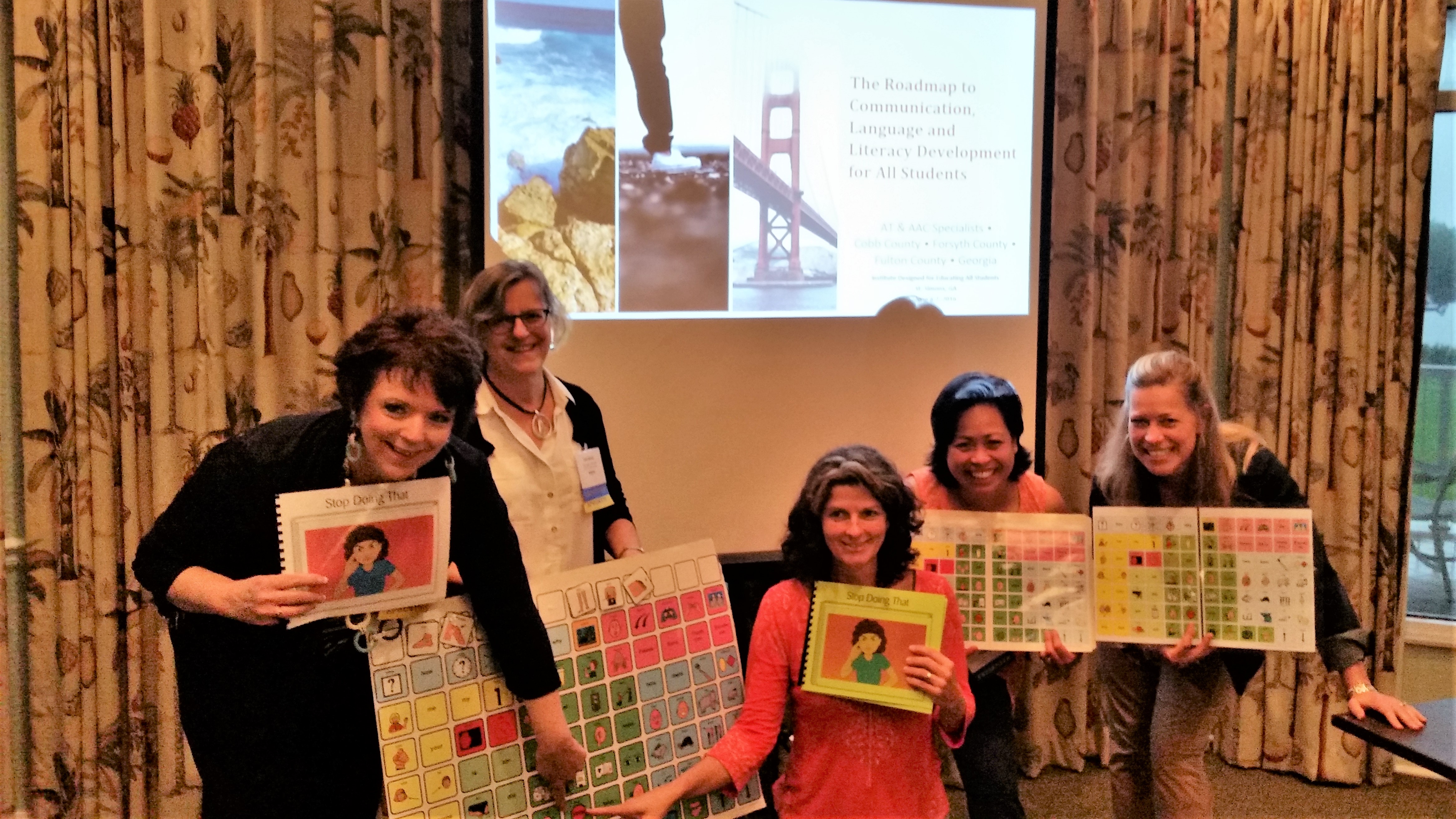
Filed under: Featured Posts, PrAACtical Thinking
Tagged With: core vocabulary, education, school
This post was written by Carole Zangari


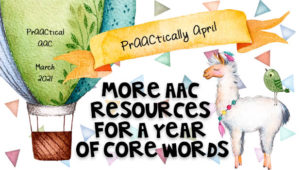
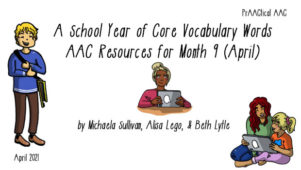

4 Comments
This is a fabulous post. Thanks so much for sharing. We are just starting a CV initiative in our District. I am going to be ordering poster size CV board for the classrooms to use. My question is what size are your poster-size boards?
Hi Marie, We wanted to make our CWB poster as easy as possible to recreate … since they will get worn or damaged from frequent use ;-).
The poster-size board is actually 8-sheets of paper that can be printed on any printer. Staff print out the sheets, glue/tape to poster boards that can be bought at regular or dollar stores, and then laminate this poster in the school laminator.
Then it can either be placed on a wall for a regular spot. Or … it can be velcro’d or taped to foam board purchased at a dollar store. It’s then light enough, but with structure to be picked up by a teacher and moved about the classroom or closer towards individual students, if necessary. When the foam board gets bent or crumply, the poster CWB can be removed and mounted to a new foam board.
Hope this helps! Jennifer
Thank you so much for your quick response.
What a great way to save money. I am still a little confused…….
We already have the CV board on an 81/2 X 11 piece of paper. I want to enlarge it to poster size for the classrooms.
I like your cost saving idea better. After putting the 8 sheets of paper together, did you put on icons on one at a time? If you did, what size were the icons?
Thanks again for your response! I really appreciate it!!
All sizes of our CWBs were created in Boardmaker. Each size was specifically created from scratch … paper, folder, poster.
Boardmaker automatically resizes the icons for the size of the button created. Hope this makes sense.